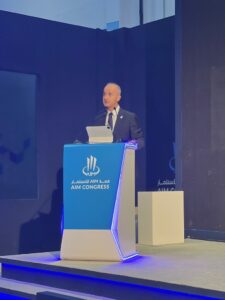- Tanzanian inches closer to clean cooking dream with roll out of $1.7 billion plan
- Why the planning of new cities must embrace a visionary approach to succeed
- First Saudi WoodShow in Riyadh attracts over 8,000 visitors
- Kenya Apparel Exports Targetting $1 Billion by 2025
- Inaction On SDGs to Cost Global Economy an Extra $38 Trillion
- Pullman Hotel Nairobi: French hospitality firm Accor to Open 1st Premium Brand in Kenya
- Investors tip Abu Dhabi as the next tech powerhouse globally
- Unlocking global investment potential: ministerial roundtable insights at AIM Congress 2024
Author: Padili Mikomangwa
Padili Mikomangwa is an environmentalist based in Tanzania. . He is passionate about helping communities be aware of critical issues cutting across, environmental economics and natural resources management. He holds a bachelors degree in Geography and Environmental Studies from University of Dar es Salaam, Tanzania.
Over the past decade, Tanzania’s oil and gas industry has demonstrated astonishing milestones in energy generation and consumption, demonstrating that an industrialized Tanzania might be a feasible ambition for East Africa’s fastest-growing economy.
Since Tanzania discovered natural gas in 1974, remarkable developments have been achieved. These include saving over $ 10 billion USD, used in purchasing heavy fuel oil (HFO) and other fossil fuels (diesel and petrol in particular) for industrial production and power generation.
According to the Ministry of Energy, until May 2019, the Tanzania Petroleum Development Corporation (TPDC) had collected over $ 210 million USD (from gas sales and exploration), exceeding the intended target of over $ 171 million for the fiscal year 2018/ 2019.
Currently the energy arena in Tanzania seems to be working positively. The upcoming Oil and Gas Congress (commencing on 2nd and 3rd of October), anticipates profitable sectorial merits, necessary to expanding …
Tanzania plans to streamline its oil and gas industry to the world, via a robust and tailor-made, two-day congress, commencing on 2nd and 3rd of October 2019.
For a third time, Tanzania will host the Oil and Gas Congress and attract delegates from over 67 nations across the globe, including sector’s crucial players: Oman, UAE, Canada, Brazil, UK, Norway, and India.
Organized by Ocean Business Partners and CWC, via a partnership with other essential government parastatals and private sector in Tanzania, the 3rd Oil and Gas Congress stands to be an event not to be missed.
Tanzania—has been ascending in the extractives sector’s ladder quite steadily over the past decade, levitating commercial aspects in natural gas production and enhancing national content take-up across the country by building capacity with local suppliers, technocrats and consumers.
In that context, the anticipated and eye-catching congress is yet another concrete and calculated …
The Southern African Development Community (SADC) envisions to create a region with an industrial complex driven economy, but also a excel in utilizing the telecommunication potential for a unique African development success story.
The SADC region which hosts more than 345 million people, took its 2019 high-end summit and meetings to Tanzania—one of the populous, fast-growing economy and trader, member state in the region.
Member states conversed on industrializing Africa on inclusive fast-growing sustainable grounds while, including intra-regional trade, but also ICT, information, transport, and meteorology.
In this context, the ICT, information, transport and meteorology member states meeting brought forth , rather essential aspects, that might stimulate the region’s economic strategies.
The meeting was hosted by the government of the United Republic of Tanzania and was attended by ministers (or their representatives) from Angola, Botswana, Eswatini, Lesotho, Malawi, Mauritius, Mozambique, Namibia, South Africa, United Republic of Tanzania, Zambia and Zimbabwe.…
Sports betting fans in Kenya, with an incentive to win a handsome load of cash, will have to rely on other outlets as large-players SportPesa and Betin quit the market in a rather disappointing manner.
The duo’s exodus, occurred shortly after a series of engagements with the government, proved to be a failure. SportPesa commented on it’s return ( to the market) conditions, citing that they would resume operations when “adequate taxation and non-hostile regulatory environment” are in place.
The latter was also compelled by the July hit, where the government ordered telcos to shut down 27 sports betting pay bills and shortcodes, SportPesa and Betin inclusively.
According to The Citizen report, the government of Kenya saw uneven distribution of the benefits within the sector, as sports betting companies garnered over $2 billion in 2018, but the government share stood at $40 million.
According to PWC, Kenya is the …
The extractive industry in Tanzania is prone to substantial operational and management changes.
Since President John Magufuli took leadership, several mining sector advancements have been made in the course of 3 years, proving billions in return at a rather intriguing socio-political cost.
The latter can be reflected, in a recent development ushered by Ministry of Mining (on September 19th 2019) directing all gold produced from Biharamulo gold mine, operated by STAMIGOLD company a subsidiary of the State Mining Cooperation (STAMICO), to be sold within Tanzania, primarily in the newly established Biharamulo gold market, by December 2019.
During the first quarter in 2019, the mining sector saw a 10 per cent growth, which was attributed by increased gold production.
However, the mining industry contributed over 5.07 per cent to Gross Domestic Product (GDP) by 2018, this being a significant increment attributed by the ongoing reformation in the sector, compelling wider …
Water sector in Tanzania stands to get a huge face-lift, following a move by the Tanzanian government experts to partner with Poland government,seeking to amend the water sector in the country.
On September 20th, Deputy Minister of Water, Juma Aweso who led the meeting along-side Poland government experts in capital city Dodoma, stated that: the meeting sole focus is to explore various areas to for improve , primarily wastewater infrastructures, energy demands, clean water supply, and management.
Tanzania stands at a significant point to harness billions from its water resources, this is due to the huge water potential it has, including it’s decent share of African great lakes: 51 per cent of Lake Victoria and 46 per cent of Lake Tanganyika.
Further, Ministry of Water envisions to secure water supply across Tanzania, within possible lengths of the Sustainable Development Goals (SDG) number 6- clean water and sanitation, Five …
On September 17th, Tanzania via Vocational Education and Training Authority (VETA) and Germany (German Corporation for International Cooperation -GIZ) have entered into an agreement in amending Tanzanian graduates’ employability via a special project named: Employment for Development.
The boost comes forth to advance youth socio-economic potentials in developing their respective economies and the nation at large. This is reflected in the context of high rates of annual graduates versus available positions in the formal sector.
Available data show, over 900,000 youth enter the job market per year in Tanzania, but only 50,000 to 60,000 formal sector jobs are created yearly. Leaving rather many graduates unemployed, this goes along with the unemployment rate in Tanzania which stands at 9.7 per cent.
The project is specifically focused on seeking various opportunities and job skills demands, existing among various investors, within the Southern regions of Tanzania, and offer graduates with necessary skill-sets …
Vodacom Tanzania Plc – the leading and fastest mobile data network in Tanzania, has recently paid its equity shareholders $23.7 million in dividends.
The payout, in other words, came out rather delightful, due to salient features from the telecom company’s annual reports, showing a $39.1 million annual (end of the year) net profit increase.
Vodacom Tanzania became the first telecom company in Tanzania to get listed in Tanzania’s stock-exchange (Dar es Salaam Stock Exchange -DSE) on August 15th 2017.
According to Vodacom Tanzania, which has over 14 million subscribers, 32.4 per cent of market share and 38.6 per cent of mobile money share, the respective profit was fetched from a significant increase in service revenue which reached $442.9 million, alleviated by firm growth of mobile money, mobile data and messaging services.
And yet, Vodacom Tanzania preliminary report (2019) show, an increase of 1.2 million customers (9.6 per cent increase), …
Land owners in Tanzania can now channel the payment of their bills via Airtel Tanzania – mobile money platform – Airtel Money.
The partnership was officiated on September 9th, in Tanzania’s capital , Dodoma by the Ministry of Lands, Housing and Settlement Development, Hon. William Lukuvi and Airtel Tanzania Corporate Communications and Regulatory Affairs Director, Beatrice Singano.
Airtel Tanzania which holds over 11 million customers which translates to 26 per cent of subscription market share, will be offering seamless utility services on land bills payment to millions of landowners across Tanzania via mobile phones.
Further, the telecommunications firm has been garnering billions from its platform Airtel Money which has more than 4.19 million accounts national wide, equivalent to 18 percent of the market share, revealed by Tanzania Communications Regulatory Authority, latest statistics.
The partnership comes at a time when the government is pushing for more efforts to harmonize various operations …
Tanzania’s government via the President’s Office Ministry of Regional Administration and Local Government (PO-RALG) with support from World Bank and UK aid as financier, has funded the Tanzania Urban Resilience Program that brought, Msimbazi Opportunity Plan.
This is the comprehensive blueprint, turning the commercial city hazardous basin into a valuable real estate asset for urban resilience.
The entire process was rooted by Tanzania’s Vice President Hon. Samia Suluhu’s quest for eliminating flooding in Dar es Salaam, resulting into a coherent participatory process to beget the Msimbazi Plan, known as “Charrette”, which began from January 2018 to August 2018. Over 200 people were involved from 59 institutions and communities.
Dar es Salaam, the commercial city with approximately 6 million people, has suffered enormously under floods over time and space, and Msimbazi Valley being the epicenter of vulnerability and stress to thousands of victims.
Msimbazi river and its tributaries flow through the …






